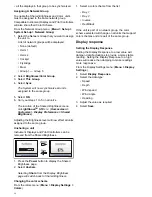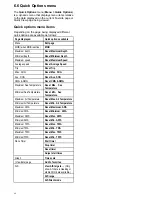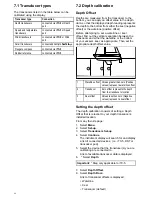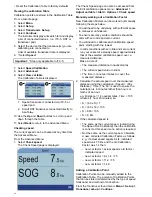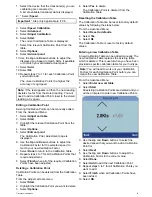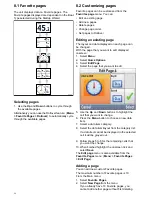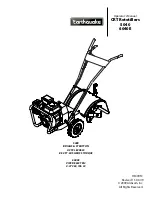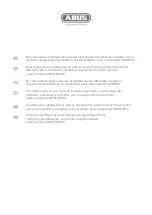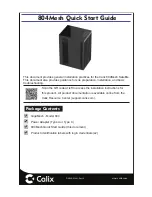
• Reset the Calibration Table to factory defaults
Viewing the calibration Table
Calibration points are stored in the Calibration Table.
From a favorite page:
1. Select
Menu
.
2. Select
Set-up
.
3. Select
Transducers Set-up
.
4. Select
Continue
.
The instrument display will search for and display
a list of connected devices. (i.e. iTC-5, DST or
transducer pod)
5. Select the device that the transducer(s) you are
calibrating are connected to.
A list of available transducer data is displayed,
6. * Select
Speed
.
Important:
* Step only applicable to iTC-5.
7. Select
Speed Calibration
.
8. Select
Advanced
.
9. Select
View cal table
.
The Calibration Table is displayed.
1.
Speed transducer connected via iTC-5 or
speed pod.
2.
Smart DST transducer connected directly to
SeaTalk
ng
.
10. Use the
Up
and
Down
buttons to scroll up and
down through the table.
11. Select
Back
to return to the Advanced Menu.
Checking speed
The current speed can be checked at any time from
the Advanced Menu.
From the Advanced Menu:
1. Select
Check speed
.
The Check Speed page is displayed:
The Check Speed page can also be accessed from
the Edit calibration options menu:
Advanced >
Adjust cal table > Start > Options > Check speed
.
Manually working out a Calibration Factor
New Calibration Factors can be worked out manually
following the steps below.
• You will need to be underway, with sufficient space
to maneuver unhindered.
• To ensure accuracy, water conditions should be
calm with zero tide and zero current.
• You will need to calibrate each calibration speed
point, starting with the lowest
1. In calm conditions with zero tide and zero current,
run your vessel at a steady speed, approximately
that of the selected calibration speed, over a
measured distance.
Make a note of:
• The measured distance in nautical miles
• The current speed value in knots
• The time in minutes it takes to cover the
measured distance
2. Calculate the actual speed over the measured
distance using the calculation: (Speed = (60 x
Distance) / Time) The ‘60’ is used to ensure the
calculation is in minutes rather than hours or
tenths of an hour.
e.g. Distance = 14 nautical miles, Time = 105
minutes (1 hour 45 minutes) so:
• S = (60 x D) / T
• S = (60 x 14) / 105
• S = 840 / 105
• S = 8 Kts
3. If the calculated speed is:
• The same as the current speed, (noted during
the Speed Run Calibration) then the calibration
is correct at this speed so no action is required.
• Not the same as the current speed. Calculate
a new, corrected Calibration Factor, as follows:
e.g. if actual speed equals 8 kts, indicated
speed was 7.5 kts and the old Calibration
Factor was 1.4 then:
– new cal factor = actual speed x old factor /
indicated speed
– new cal factor = 8 x 1.4 / 7.5
– new cal factor = 11.2 / 7.5
– new cal factor = 1.49
Adding a Calibration Point
Calibration Points can be manually added to the
Calibration Table. The amount of Calibration Points
that can be stored is determined by the type of speed
transducer and method of connection.
From the Transducer found menu:
Menu > Set-up >
Transducer set-up > Continue
:
46







